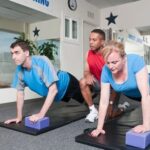How should workout shoes fit? Finding the perfect pair of workout shoes is crucial for your overall fitness and health journey. Proper fitting workout shoes not only enhance your performance but also prevent injuries and discomfort during exercise. Understanding the anatomy of workout shoes and knowing what to look for in a good-fitting pair is essential to ensure that you get the most out of your workouts.
When it comes to selecting workout shoes, size matters. Getting the right shoe size is not just about comfort but also about safety and performance. Factors like arch support, cushioning, and stability features play a significant role in how well a shoe fits your feet. By paying attention to these elements, you can ensure that your workout shoes provide the necessary support and protection for your feet during physical activity.
Trying on workout shoes properly is key to ensuring the perfect fit. It is essential to consider factors like toe room, heel fit, and overall comfort when trying on different pairs of workout shoes. Addressing common fitting issues such as over pronation or under pronation is also crucial for finding the right fit. By understanding how these issues affect your gait and posture, you can make an informed decision when selecting workout shoes that cater to your specific needs.
Understanding the Anatomy of Workout Shoes
When it comes to workout shoes, finding the right fit is essential for comfort, performance, and injury prevention. Understanding the anatomy of workout shoes can help you identify what to look for in a good-fitting pair. Here are some key features to consider:
- Toe box: The front part of the shoe should provide enough room for your toes to wiggle without feeling cramped. A too tight toe box can lead to discomfort and pain during workouts.
- Heel counter: The heel counter is the back of the shoe that holds your heel in place. It should be firm and snug to prevent any slippage or instability while exercising.
- Midsole: This is the cushioning layer between the outer sole and the insole. Look for adequate cushioning in the midsole to absorb impact and provide support during high-impact activities.
Getting familiar with these aspects of workout shoes can guide you in selecting a pair that fits well and meets your specific needs based on the type of exercise you engage in. Always remember that different shoe brands and models may vary in their fit, so it’s crucial to try on different options before making a purchase.
In addition to understanding these components, it’s also important to consider any unique foot characteristics you may have, such as high arches or flat feet. Different types of workout shoes offer varying levels of arch support, cushioning, and stability features to accommodate these needs. By paying attention to these details, you can ensure that your workout shoes provide the necessary support and comfort for your feet while training.
Size Matters
When it comes to workout shoes, one of the most crucial aspects to consider is getting the right shoe size. Ill-fitting shoes can not only impact your performance but also put you at risk for injuries during your workouts. So, how should workout shoes fit? Here are some key points to keep in mind:
- Proper Fit: Workout shoes should feel snug but not tight, with enough room for your toes to move comfortably. Your heel should be secure and not slipping out of the shoe while walking or running.
- Toe Box Space: Make sure there is ample space in the toe box area to prevent crowding and potential discomfort or injury like black toenails or blisters.
- Width: Consider the width of your foot when trying on workout shoes. Some brands offer different widths to accommodate various foot shapes.
Having the correct shoe size is vital for both performance and safety during your workouts. Too small or too big shoes can lead to issues such as blisters, calluses, foot pain, and even more serious injuries like stress fractures. Furthermore, wearing improperly sized shoes can affect your balance and stability during exercises, potentially compromising your workout effectiveness.
Remember that sizing may vary between different brands and styles of workout shoes, so it’s essential to try on multiple options before making a purchase. Don’t hesitate to ask a knowledgeable staff member at the store for assistance in finding the right fit for your feet. Prioritizing comfort and proper fit over aesthetics will ultimately benefit your overall training experience and prevent unnecessary discomfort or injuries down the road when engaging in physical activities.
Factors to Consider
When it comes to finding the perfect workout shoes, there are several factors to consider to ensure a proper fit. One of the main aspects to look for in workout shoes is the level of arch support they provide.
The arch of your foot plays a crucial role in how weight is distributed and how your foot absorbs shock during physical activity. A good-fitting shoe should have adequate arch support that matches the natural curve of your foot, providing stability and preventing issues like plantar fasciitis or flat feet.
In addition to arch support, cushioning is another important factor to consider in workout shoes. The amount and type of cushioning can make a significant difference in comfort, impact absorption, and overall performance during exercise. Shoes with too little cushioning can lead to discomfort and even injuries, while shoes with too much cushioning may affect stability and balance. It’s essential to find a balance that suits your specific needs and preferences for optimal performance.
Lastly, stability features are key components of well-fitting workout shoes. These features help control the motion of your foot during different types of exercises, providing support and preventing potential injuries.
Look for shoes with sturdy soles, secure heel counters, and structured designs that promote proper alignment and reduce the risk of overpronation or underpronation. By taking into account arch support, cushioning, and stability features, you can ensure that your workout shoes fit properly and help you achieve your fitness goals safely and effectively.
Trying on Workout Shoes
When it comes to workout shoes, having the perfect fit is crucial for comfort, performance, and most importantly, injury prevention. So, how should workout shoes fit? The first step is to ensure that there is enough room in the toe box – you should be able to wiggle your toes comfortably. The shoe should also provide ample support and cushioning for your feet to reduce the impact of high-intensity workouts on your joints.
Additionally, pay attention to the width of the shoe. Your foot should not feel cramped or overly tight in the midfoot section. It’s essential to try on workout shoes later in the day when your feet are slightly swollen from daily activities to get a more accurate fit. Remember that sizes may vary between different brands, so always try on multiple pairs and walk around in them before making a decision.
Another vital factor to consider for a proper fit is the arch support of the shoe. Depending on whether you have high arches, low arches, or neutral arches, look for shoes that provide adequate support in alignment with your foot structure. Proper arch support can prevent issues like plantar fasciitis or shin splints, ensuring you can exercise comfortably and safely.
| Shoe Fit Recommendation | Description |
|---|---|
| Toe Box Fit | Ensure enough room for comfortable toe movement |
| Width Check | Avoid cramped midfoot sections for proper width |
| Arch Support | Select shoes with appropriate arch support based on foot type |
Common Fitting Issues
Understanding Over Pronation and Under Pronation
Overpronation and under pronation are common issues that can arise when wearing workout shoes that do not fit properly. Overpronation occurs when the foot rolls inward excessively, putting strain on the ankle and knee joints. On the other hand, under pronation (also known as supination) happens when the foot does not roll inward enough, leading to uneven distribution of weight and pressure on the foot.
Addressing Over Pronation and Under Pronation
To address these fitting issues, it is important to select workout shoes with proper support and stability features. Look for shoes that offer motion control and stability for overpronators, such as a firm midsole and structured arch support. For under pronators, cushioning is key to absorb shock and provide adequate support for the foot.
Tips for Finding the Right Shoes for Your Pronation Type
Before purchasing workout shoes, consider getting a gait analysis done at a specialty shoe store or sports retailer. This will help determine your pronation type and guide you in selecting the appropriate footwear. It is also important to try on multiple pairs of shoes and walk around in them to assess comfort, fit, and support. Remember that each individual may have unique fitting needs based on their foot structure and biomechanics.
Overall, addressing over pronation and under pronation by choosing well-fitted workout shoes can significantly improve your performance, reduce the risk of injury, and enhance your overall comfort during workouts. Be mindful of any discomfort or pain while wearing your workout shoes as this could be a sign of improper fit or support. Prioritize finding the right fit to optimize your training experience and protect your feet from unnecessary strain or injuries.
Signs of Ill-Fitting Shoes
Ill-fitting workout shoes can have a significant impact on your performance and overall foot health. It is crucial to pay attention to signs that indicate your workout shoes are not the right fit.
One of the first warning signals to watch out for is discomfort or pain in your feet while exercising. If you experience any pain or discomfort, especially in your arches, heels, or ankles, it may be a sign that your shoes are not providing adequate support or cushioning.
Another common sign of ill-fitting workout shoes is blisters, calluses, or hot spots on your feet. These issues arise when there is excessive friction between your skin and the shoe due to improper fit. Tightness in certain areas or inadequate cushioning can lead to these uncomfortable skin problems. Additionally, if you notice that your toenails are getting bruised or blackened after workouts, it could be a red flag that your shoes are too small and causing impact-related injuries.
Furthermore, pay attention to any changes in your gait or posture while wearing your workout shoes. If you find yourself tripping more often, experiencing instability during exercises, or feeling like you are walking differently than usual, it could be a result of shoes that do not provide sufficient support or stability. To avoid these issues, ensure that you regularly assess how well your workout shoes fit and listen to what your body is telling you about their comfort level.
| Signs of Ill-Fitting Shoes | Warning Signals |
|---|---|
| Pain or discomfort in feet while exercising | Indicates inadequate support or cushioning |
| Blisters, calluses, or hot spots on feet | Result of excessive friction due to improper fit |
| Bruised toenails after workouts | May signal that shoes are too small and causing impact injuries |
Maintenance and Care Tips
Maintaining and caring for your workout shoes is crucial in ensuring they fit well and remain effective for a long time. By taking proper care of your shoes, you can not only extend their lifespan but also continue to reap the benefits of wearing them during your workouts.
Proper Cleaning Techniques
One important aspect of maintaining workout shoes is keeping them clean. Remove any dirt or debris from the outer surface by using a soft brush or cloth. For tougher stains, consider using a mild soap or specialized shoe cleaner. Avoid putting them in the washing machine as this can damage the materials.
Allowing Proper Drying Time
After cleaning your workout shoes, it’s essential to let them dry properly before wearing them again. Air drying is the best method as it helps prevent damage to the shoe’s materials. Stuffing them with paper towels can help soak up excess moisture and maintain their shape.
Storage Tips
When not in use, store your workout shoes in a cool, dry place away from direct sunlight. Avoid leaving them in a hot car or damp environment as this can cause damage to the materials and affect the fit of the shoes. Consider using a shoe tree or stuffing them with tissue paper to help maintain their shape.
By following these maintenance and care tips, you can ensure that your workout shoes fit well for a long time, providing you with the support and comfort needed during your exercise routines. Proper upkeep will not only benefit the longevity of your shoes but also contribute to your overall health and fitness goals. Remember that investing time in caring for your workout shoes will pay off in the form of continued performance and protection for your feet.
Conclusion
When it comes to your health and fitness journey, the impact of well-fitting workout shoes cannot be overstated. The right pair of workout shoes can make a significant difference in your performance, comfort, and even help prevent injuries. Understanding how should workout shoes fit is crucial in ensuring that you get the most out of your workouts while keeping your feet safe and supported.
Properly fitting workout shoes should provide adequate arch support, cushioning, and stability features to support your feet during various exercises. These factors not only enhance your performance but also reduce the risk of developing foot problems or discomfort. It is essential to pay attention to the size of the shoe as well, as getting the right size can prevent issues like blisters, calluses, or even more serious injuries.
In conclusion, investing time and effort into finding the perfect pair of workout shoes for your needs is essential for your overall health and fitness journey. By understanding what to look for in a good-fitting pair, addressing common fitting issues like over pronation or under pronation, and recognizing signs of ill-fitting shoes, you can ensure that your footwear supports you every step of the way.
Remember, well-fitting workout shoes are not just about comfort – they are an integral part of taking care of yourself while striving towards your fitness goals.
Frequently Asked Questions
Should Workout Shoes Be Tight or Loose?
Workout shoes should ideally fit snugly but not too tight. A tight shoe can restrict blood flow and cause discomfort, while a loose shoe can lead to blisters and injuries during exercise. It’s important to find the right balance for proper support.
How Should a Gym Shoe Fit?
A gym shoe should fit comfortably with enough room for your toes to wiggle but not too much extra space that your foot slides around when you move. The shoe should provide adequate support for your arches and heels to prevent any strain or injuries during workouts.
Should Workout Shoes Be a Little Big?
Workout shoes should not be excessively big as this can lead to instability and discomfort during physical activities. However, having a little bit of room in the toe box allows your feet to naturally swell while exercising, providing some breathing space without compromising the overall fit and support of the shoe.

Passionate about providing useful information to anyone with an interest in the field of Personal Training, I strive to pass on to our readers quality information and to answer any questions about Personal Trainers, the work they do and how to become one.





